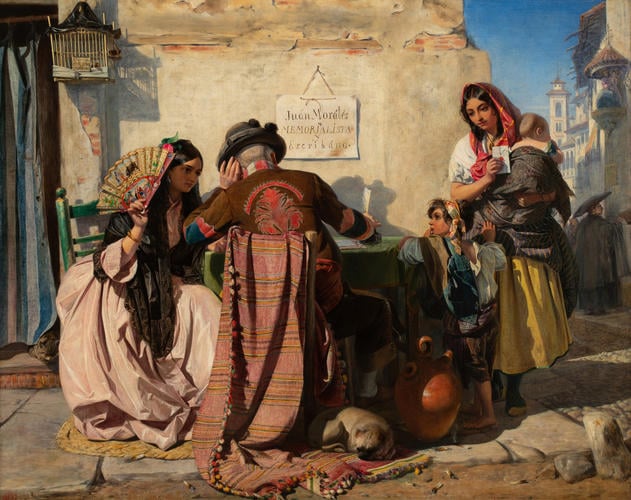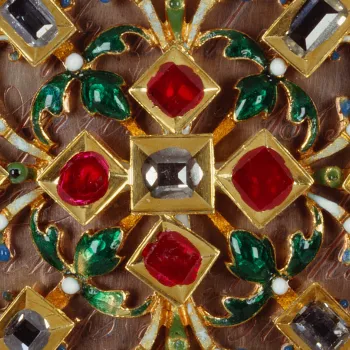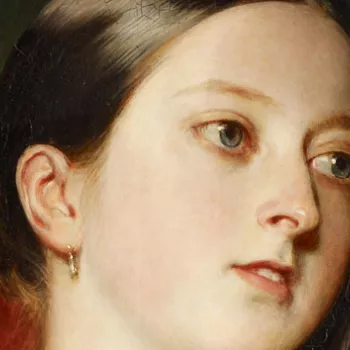The Letter-Writer of Seville Signed and dated 1854
Oil on canvas | 78.4 x 99.1 cm (support, canvas/panel/stretcher external) | RCIN 401188
-
A man with his back towards the viewer sits at a table on a street corner listening attentively to an elegantly dressed lady as she dictates a letter. His name, Juan Moráles, and occupation as memorialista y escribáno (writer of letters and memorials) are declared by a placard on the wall. A poor mother waits nearby with her two children, clutching a letter she would like him to read. Such a service was particularly important in a country where approximately 70 per cent of the adult population were illiterate in 1860 (Frago 1990, p.274). The painting was praised at the Royal Academy for its ‘atmosphere, local character, and brilliant colouring’ (New Monthly Magazine, 1854, p.48) and was also well received at the International Exhibition in Paris in 1855.
The Andalucian region was famous for the traditional majo (male) or maja (female) costume which developed at first among the peasantry but spread to fashionable society during the latter part of the eighteenth and early nineteenth centuries. The letter writer wears a typical majo outfit of striped scarf with an appliqué jacket and soft felt hat. The beautiful young lady to his left wears a traditional black lace mantilla over her shoulders, attached to a hair comb, and carries a fan decorated with scenes of bull fighting. While shielding her from the sun, the fan also lends privacy - perhaps she is dictating a love letter. The Victorians were particularly interested in Spain and Spanish culture, which they considered picturesque and exotic – a view promoted by literature including Lord Byron’s Don Juan (1819) and Prosper Merimée’s Carmen (1845), as well as by Richard Ford’s ground-breaking guide to the country and the habits of its people, Hand-book for Travellers in Spain (1845).
John Phillip was born in Aberdeen, but after training at the Royal Academy Schools settled in London, where he joined The Clique, a group of artists which included William Powell Frith and Richard Dadd. Phillip first visited Spain in 1851, and spent eight months in the country – earning the nickname of ‘Phillip of Spain’. Queen Victoria and Prince Albert were introduced to his work by Edwin Landseer. The Queen wrote in October 1852: ‘We were much pleased with some sketches & studies, of Spanish gypsies at Seville & Ronda, & of some Sevillanas, by an artist of the name of Phillip’ (Journal, 31 October, 1852). The couple subsequently bought several other paintings from the artist and also commissioned him to paint the marriage portrait of the Princess Royal and Prince Frederick William of Prussia (RCIN 406819) in place of the otherwise committed Frith. The Letter Writer of Seville was hung in the Duchess of Kent’s Sitting Room at Osborne.
Signed and dated: JP [in monogram] 1854
Text adapted from Victoria and Albert: Art & Love, London, 2010Provenance
Purchased by Prince Albert (£367 10s, PA Ledgers 1854/37)
Given to Queen Victoria by Prince Albert, 24th December 1854. [Victoria & Albert: Art & Love, London, 2010, pg 458]
-
Creator(s)
Acquirer(s)
-
Medium and techniques
Oil on canvas
Measurements
78.4 x 99.1 cm (support, canvas/panel/stretcher external)
109.2 x 129.7 cm (frame, external)
Category
Object type(s)











